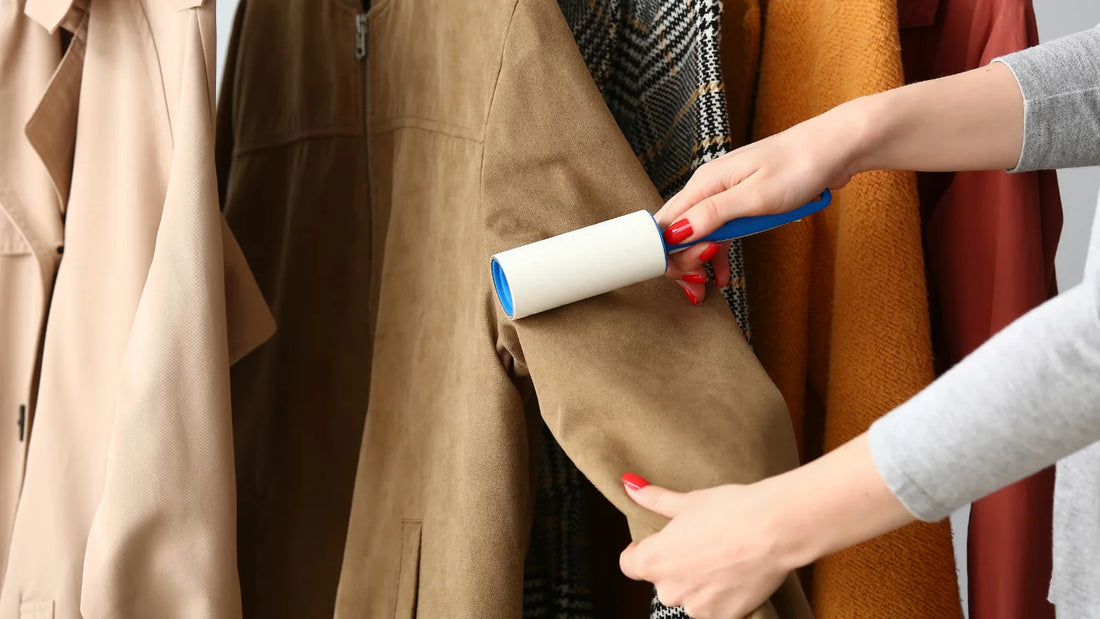We've all been there – you put on your favourite sweater, and suddenly, it's covered in annoying little fuzz, lint balls, and even those pesky pills. You might wonder, what causes this annoyance and how can you prevent it.
We'll delve into the mysteries of lint, its causes, and prevention methods, and even explore if your washing machine could be contributing to the problem. By the end, you'll be armed with the knowledge to keep your clothes lint-free and looking fresh!
What is lint on clothes?
Lint refers to those tiny fibres, fuzz, and lint balls that can cling to your clothing, making them appear less clean and well-kept. They can be especially noticeable on dark fabrics. Lint is often a combination of loose fibres from the fabric itself and other particles it picks up, such as pet hair, dust, or tiny fabric pills.
What causes lint on clothes?
Several factors contribute to lint on clothes:
- Friction: Regular wear and washing can cause fibres to break loose and form lint balls.
- Low-quality fabric: Cheaper fabrics tend to shed fibres more easily.
- Washing machine agitation: While washing machines are generally safe, over-agitation can lead to lint formation.
- Mixed fabric loads: Washing clothes with fabrics that shed easily alongside those that attract lint can exacerbate the issue.
- Static electricity: Static can attract lint and make it cling to clothes.
How to remove lint from clothes without a lint roller
Homemade lint roller
All you need is a long rolling pin and some packaging tape. Wrap the tape around the rolling pin with the sticky side facing outwards. Then, roll it over your clothes to pick up the lint.
Use your hand
If you don’t have a rolling pin, simply wrap packaging tape around your fingers with the sticky side facing outwards. Pat your garments with your hand to lift off the lint.
Packaging tap strips
Cut strips of packaging tape and apply them directly to your clothes, pressing down firmly to pick up the lint.
Velcro
If you have strips of Velcro lying around, use them instead of packaging tape. The hooks on the Velcro will catch and remove the lint from your clothes.
Shaving razor
Gently shave the surface of your garment with a clean shaving razor to remove lint. Be careful not to apply too much pressure to avoid damaging the fabric.
How to remove lint from woollen clothes
Woollen clothes can be particularly tricky because they often become static, making lint removal a bit more challenging.
- Dryer sheet: Rubbing a dryer sheet against your woollen clothes helps to remove lint and reduce static at the same time.
- Rubber glove: Use a rubber glove to rub down your woollen garments. The rubber will attract lint and make it easy to wipe away.
- Nylon: Pull a nylon sock or stocking over your hand and rub it over your woollen sweater. The lint will stick to the nylon, making it easy to remove.
How to remove lint from black shirts, hoodies, and pants
Lint is more visible on dark-coloured clothing, so here are some additional tips to keep your black shirts, hoodies, and pants looking sharp.
- Wash again: Give your clothes an extra wash without detergent to help remove any remaining lint. Adding fabric softener can also help.
- Wash with vinegar: Add distilled white vinegar to your wash cycle. It helps prevent static and softens fabrics, making lint removal easier.
- Antistatic spray: Use an antistatic spray on your clothes before removing lint to help make the process smoother.
How to prevent lint on clothes in a washing machine
Turn clothes inside out
When washing and drying your clothes, turn them inside out. This simple trick minimizes friction between the fabric's exterior and other garments, which can lead to lint formation. It's particularly useful for preventing lint balls and fuzz on dark-coloured clothing. Use Hapiso laundry pods for the best results.
Wash similar textures together
Prevention is key when it comes to lint. Wash clothes with similar textures together to minimize friction that can lead to lint and fuzz. For example, wash denim with denim and delicate fabrics with other delicate fabrics. This reduces the chances of lint transfer during the washing process.
Check pockets
Always check pockets for tissues or other lint-producing items before washing.
Choose the right laundry detergent
Opt for high-quality detergents like Hapiso laundry pods. Their advanced formula not only cleans your clothes effectively but also helps prevent lint build up. The gentle yet thorough cleansing action of Hapiso pods reduces fibre breakage and helps maintain the quality of your clothes.
Can a washing machine cause pilling?
Yes, a washing machine can contribute to pilling if it's too harsh on clothes. Overloading the machine, using high agitation settings, or washing clothes with rough items like zippers can lead to fabric friction and pilling. To prevent this, wash delicate items in a mesh laundry bag and use a gentle cycle.
Remember to use lint rollers, fabric shavers, or tape for quick fixes, while also practicing good washing machine and dryer maintenance to prevent excessive lint build up. With these simple steps, you can easily remove lint, fuzz, lint balls, and even fabric pills from your clothes. Remember, prevention is key, so practice good laundry habits to minimize the occurrence of lint. By following these steps, your clothes will look cleaner, more polished, and ready to wear. Say goodbye to annoying lint and hello to fresh, lint-free outfits!

